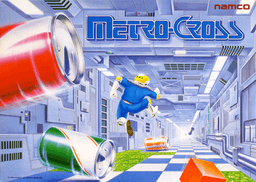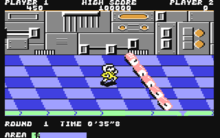Metro-Cross
Metro-Cross[lower-alpha 1] is a platform arcade game that was released by Namco in 1985. It runs upon Namco Pac-Land hardware (but with a video system like that used in Dragon Buster, modified to support a 2048-color palette). It uses a Motorola M6809 microprocessor, with a Hitachi HD63701 sub-microprocessor (both running at 1.536 MHz) and Namco 8-channel waveform PSG for audio.
| Metro-Cross | |
|---|---|
 Japanese promotional sales flyer | |
| Developer(s) | Namco |
| Publisher(s) | |
| Designer(s) | Tatsuro Okamoto |
| Composer(s) | Nobuyuki Ohnogi |
| Platform(s) | Arcade, Amstrad CPC, Atari ST, Commodore 64, Family Computer, ZX Spectrum |
| Release | |
| Genre(s) | Platform |
| Mode(s) | Single-player, multiplayer |
| Cabinet | Upright, tabletop |
| Arcade system | Namco Pac-Land |
| CPU | Motorola 6809 |
Gameplay
.png)

The player must take control of a man known only as Runner, who is given a time limit to run through each of the game's thirty-two rounds while avoiding obstacles and collecting drink cans. The actual running happens automatically: the job of the player is to avoid the obstacles and collect the cans by moving the Runner with the stick and adjusting his speed accordingly.
If the Runner finishes the round within the time limit, the remaining time will be awarded to him as bonus points and he will proceed to the next round. Every fourth round is special, using the remaining time from the three previous ones as additional time. However, if the Runner has not finished the round by the time the time limit runs out, he will be electrocuted and the game will immediately be over.
Obstacles along the way include Slip Zones which will slow the Runner down if he tries to cross over them, Pitfalls which will break under the Runner's weight and drop him into the holes beneath them, and Crackers which will launch the Runner up into the air and cause him to land on his back. Later rounds also feature Jumbo Tires that bounce towards the Runner, Walls that emerge from the ground before receding back into it, Cubes that move through particular columns of tiles, Mice that attempt to jump onto the Runner and slow him down, and Chess Knights and Kings that bounce from one tile to another.
The rounds also feature Springboards, which can be used to propel the Runner forward at a great speed. Some rounds have a special layout of Springboards, where it is possible to use one Springboard to land directly on the second one. Some other rounds also feature Skateboards which will speed the Runner up and make him immune to Slip Zones. There are also two different types of drink cans; kicking them will either gain the player bonus points (from 100 to 5000) or speed the Runner up, but jumping on them will stop the timer for a few seconds.
Development and release
Metro-Cross was released in Japan by Namco in May 1985, licensed to Kitkorp for release in the United States and Europe later that year. The game was designed by Tatsuro Okamoto, with music composed by Nobuyuki Ohnogi. Masanobu Endo, known as the creator of Xevious and The Tower of Druaga, is also credited as a designer. The game ran on the Namco Pac-Land arcade system, and was one of the only games to run on the hardware.
Reception
In Japan, Game Machine listed Metro-Cross on their June 15, 1985 issue as being the ninth most-successful table arcade unit of the year.[1]
Legacy
Metro-Cross was re-released as part of Namco Museum Volume 5 for PlayStation[2] and Namco Museum Virtual Arcade for Xbox 360 (renamed Retro-Cross in the European and Australian versions of Virtual Arcade).
A high definition sequel called Aero-Cross was being developed for the Xbox Live Arcade and PlayStation Network as part of the Namco Generations line until it was cancelled along with the Namco Generations brand itself being discontinued; multiple players would have been able to play simultaneously, similar to Konami's Hyper Olympic games.
Notes
References
- "Game Machine's Best Hit Games 25 - テーブル型TVゲーム機 (Table Videos)". Game Machine (in Japanese). No. 262. Amusement Press, Inc. 15 June 1985. p. 25.
- Levy, Stuart; Semrad, Ed (January 1997). "PlayStation Expo '96-'97: Namco Steals the Show with Five New Arcade Conversions!". Electronic Gaming Monthly. No. 90. Ziff Davis. p. 110.